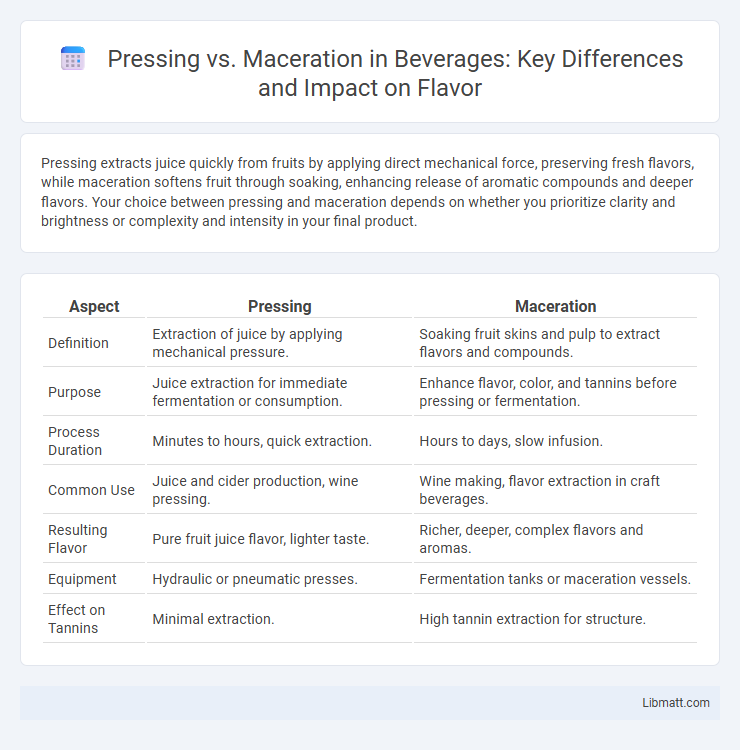Pressing extracts juice quickly from fruits by applying direct mechanical force, preserving fresh flavors, while maceration softens fruit through soaking, enhancing release of aromatic compounds and deeper flavors. Your choice between pressing and maceration depends on whether you prioritize clarity and brightness or complexity and intensity in your final product.
Table of Comparison
| Aspect | Pressing | Maceration |
|---|---|---|
| Definition | Extraction of juice by applying mechanical pressure. | Soaking fruit skins and pulp to extract flavors and compounds. |
| Purpose | Juice extraction for immediate fermentation or consumption. | Enhance flavor, color, and tannins before pressing or fermentation. |
| Process Duration | Minutes to hours, quick extraction. | Hours to days, slow infusion. |
| Common Use | Juice and cider production, wine pressing. | Wine making, flavor extraction in craft beverages. |
| Resulting Flavor | Pure fruit juice flavor, lighter taste. | Richer, deeper, complex flavors and aromas. |
| Equipment | Hydraulic or pneumatic presses. | Fermentation tanks or maceration vessels. |
| Effect on Tannins | Minimal extraction. | High tannin extraction for structure. |
Introduction to Pressing and Maceration
Pressing and maceration are key winemaking techniques that significantly influence wine flavor and aroma profiles. Pressing involves extracting juice from grapes by applying mechanical force, maximizing juice yield while preserving delicate flavor compounds. Maceration is the process where grape skins soak in the juice, promoting color, tannin extraction, and enhancing the wine's complexity and structure.
Key Differences: Pressing vs Maceration
Pressing involves mechanically extracting juice from grapes, whereas maceration refers to soaking crushed grapes to enhance flavor and color extraction. Pressing typically occurs after fermentation, separating juice or wine from solids, while maceration happens before or during fermentation to increase tannin and pigment levels. These processes differ in purpose, timing, and impact on wine's taste, texture, and appearance.
The Science Behind Pressing
Pressing in winemaking involves applying mechanical force to grape skins to extract juice, carefully controlling pressure to maximize liquid yield while minimizing bitter phenolics. This process differs from maceration, where grape skins soak in juice to enhance color and flavor extraction through enzymatic reactions over time. Precise pressing techniques influence tannin levels, juice clarity, and overall wine texture, making it a critical step in determining the final wine profile.
The Role of Maceration in Flavor Extraction
Maceration plays a crucial role in flavor extraction by allowing grape skins, seeds, and stems to soak in the juice, intensifying color, tannins, and aromatic compounds essential for wine complexity. Unlike pressing, which primarily separates juice from solids, maceration facilitates the transfer of phenolic compounds, directly influencing the wine's structure and mouthfeel. Extended maceration periods enhance depth and richness, particularly in red wines, by promoting a robust extraction of flavors and textures.
Equipment Used in Pressing and Maceration
Pressing in winemaking involves equipment like hydraulic presses or bladder presses, which apply controlled pressure to extract juice from crushed grapes efficiently. Maceration utilizes fermentation tanks or open-top vats designed to allow prolonged contact between grape skins and juice, promoting color and flavor extraction without mechanical pressure. Each method's specialized equipment directly influences the wine's texture, tannin levels, and aromatic profile.
Pressing Methods: Traditional and Modern Approaches
Traditional pressing methods involve manual or lever presses that apply gradual pressure to extract juice from fruits, preserving delicate flavors and aromas. Modern pressing techniques utilize pneumatic or hydraulic presses, offering precise control over pressure and efficiency, resulting in higher juice yields and consistency. Both approaches impact juice quality, with traditional methods favored for artisanal products and modern presses suited for large-scale production.
Types of Maceration Processes
Maceration involves soaking fruit or plant materials in liquid to extract flavors, pigments, and bioactive compounds, with common types including cold maceration, carbonic maceration, and heat-assisted maceration. Cold maceration preserves fresh aromas by maintaining low temperatures, while carbonic maceration enhances fruity and wine complexity through anaerobic fermentation inside whole berries. Understanding these maceration processes helps optimize extraction techniques to improve Your product's sensory profile and overall quality.
Impact on Wine Quality and Characteristics
Pressing and maceration distinctly influence wine quality and characteristics by shaping color, tannin levels, and flavor profiles. Pressing extracts juice with minimal skin contact, resulting in lighter, more delicate wines with lower tannins, while maceration prolongs skin contact, enhancing color intensity, tannin structure, and complex aromas in red wines. Your choice between these techniques directly impacts the wine's body, aging potential, and overall sensory experience.
Choosing the Right Technique for Desired Results
Pressing and maceration are crucial techniques in juice extraction and winemaking, each offering distinct impacts on flavor and clarity. Pressing efficiently separates juice from solids, resulting in clearer liquids with a lighter taste, while maceration enhances color and intensifies flavor by allowing juice to soak with skins and seeds. Choosing the right technique depends on your desired outcome; pressing suits delicate, crisp flavors, whereas maceration is ideal for robust, flavorful profiles.
Future Trends in Pressing and Maceration Techniques
Pressing and maceration techniques are evolving with an emphasis on sustainability and precision, incorporating advanced sensor technology to optimize extraction and flavor profiles. Innovations in gentle pressing methods and controlled maceration environments aim to enhance wine complexity while preserving delicate aromas and tannins. Your winemaking process can benefit from these future trends by improving efficiency and elevating product quality through data-driven adjustments.
Pressing vs maceration Infographic

 libmatt.com
libmatt.com